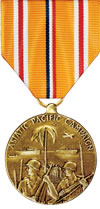The Asiatic-Pacific Campaign Medal was awarded to personnel for service within the Asiatic-Pacific Theater between 7 December 1941 and 2 March 1946 under any of the following conditions:
(1) On permanent assignment.
(2) In a passenger status or on temporary duty for 30 consecutive days or 60 days not consecutive.
(3) In active combat against the enemy and was awarded a combat decoration or furnished a certificate by the commanding general of a corps, higher unit, or independent force that he actually participated in combat.
b. The eastern boundary of the Asiatic-Pacific Theater is from the North Pole, south along the 141st meridian west longitude to the east boundary of Alaska, then south and southeast along the Alaska boundary to the Pacific Ocean, then south along the 130th meridian to its intersection with the 30th parallel north latitude, then southeast to the intersection of the Equator and the 100th meridian west longitude, then to the South Pole. The western boundary of the Asiatic-Pacific Theater is from the North Pole south along the 60th meridian east longitude to its intersection with the east boundary of Iran, then south along the Iran boundary to the Gulf of Oman and the intersection of the 60th meridian east longitude, then south along the 60th meridian east longitude to the South Pole. The Asiatic-Pacific Theater included Alaska, Hawaii, Philippines, Australia, New Zealand, and all of Asia.
 |